Papers by Indra Sandinirwan
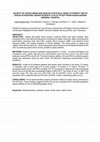
Kongres Nasional Ilmu Kesehatan Anak (KONIKA) XIX, 2024
OBJECTIVE: Sepsis and septic shock remain a serious illness with high mortality, often exceeding ... more OBJECTIVE: Sepsis and septic shock remain a serious illness with high mortality, often exceeding 40%, and need hemodynamic monitoring for better outcomes. Basic hemodynamic parameters, including heart rate (HR), systolic blood pressure (SBP), and diastolic blood pressure (DBP), are readily available in clinical settings. This study aimed to assess the validity of the Shock Index (SI = heart rate/systolic blood pressure) and Diastolic/Systolic (D/S) ratio in predicting septic shock among pediatric sepsis patients.
METHODS: Medical records of pediatric sepsis patients (1 month - 18 years) admitted to the emergency room, wards, high care unit, and intensive care unit from June to July 2024 were analyzed using SPSS version 26. The discriminatory ability of SI and D/S for predicting septic shock was assessed using the Area Under the Receiver Operating Characteristic Curve (AUROC).
RESULTS: A total of 24 pediatric patients with sepsis were included in the study (13 males, 11 females), with a mean age of 6.75 years (range 1.5 months to 17 years). Of these, 17 developed septic shock, with 59% mortality (10/17). Among the 7 patients who did not develop shock, the survival rate was considerably higher at 86% (6/7). The mean SI was 1.8 (SD 0.52) and the mean D/S ratio was 0.61 (SD 0.09). The SI (AUROC 0.613, cut-off value 1.03, sensitivity 94%) outperformed the D/S ratio (AUROC 0.366) in predicting septic shock.
CONCLUSION: The SI demonstrated superior predictive ability for septic shock compared to the D/S ratio. These findings suggest that the SI may be a valuable tool in identifying pediatric sepsis patients at risk of developing septic shock.
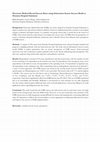
ISQua's 39th Conference, 2023
Background: Electronic Medical Records (EMRs) are newly adopted in Hermina Hospital Sukabumi to i... more Background: Electronic Medical Records (EMRs) are newly adopted in Hermina Hospital Sukabumi to improve patient care and enhance clinical workflows. However, implementing these systems in our hospital requires evaluation and improvement. As a primary user group, nurses play a crucial role in the success of EMRs. This mixed methods study aimed to investigate the success rates of EMRs from the perspective of nurses at Hermina Hospital Sukabumi, Indonesia, and to identify factors that influence their perceptions of EMR success. Methods: A sample of 108 nurses from Hermina Hospital Sukabumi were selected through stratified and purposive sampling methods, with one head nurse per unit. The study used an information success system model (ISSM) to gather quantitative data on nurses' perceptions of EMR success. Semi-structured interviews were also conducted to gather qualitative data on the factors influencing their perceptions. The data were analyzed using multivariate regression and qualitative methods. Results: Respondents consisted of 99 nurse practitioners and nine head nurses, with the number of each room consisting of 12 respondents in the intensive care unit, 15 respondents in the emergency room, seven respondents in the delivery room, 22 respondents in the operating room, 33 respondents in inpatient care, 94 respondents in the outpatient unit. Most respondents had an undergraduate education level and had 1-3 years of work experience. The EMR success rate based on the scoring results from the ISSM research questionnaire on 108 participants was 75.82% (very successful). The lowest value is 65.77%, and the highest is 98.08%. The success rate for each factor, such as Technology, Human Resources, Organizational, Ease of Use, Usefulness, and Net Benefit was 77.69%, 73.35%, 75.19%, 76.37%, 75.12%, and 75.72%, respectively. Each factor significantly affects the EMR Success rate (P<0.001). The use of EMR is preferred due to its accessibility and flexibility. Difficulty is encountered as some elements are not fully integrated into the system, which requires additional steps such as downloading from a web portal, filling in via a pdf application, and re-uploading back into the system. Conclusion: The study found that the EMR success rate and success rate for each factor were very high based on the scoring results from the ISSM model. However, it was also found that some elements of the EMR system were not fully integrated, causing difficulty for nurses and requiring time-consuming additional steps. It's important to address this issue promptly to ensure appropriate working time allocation for nurses and improve the success of EMR implementation.
Hermina Hospital Articles, 2020
Anak-anak, remaja, dan dewasa muda berisiko mengalami defisiensi (kekurangan) dan insufisiensi (k... more Anak-anak, remaja, dan dewasa muda berisiko mengalami defisiensi (kekurangan) dan insufisiensi (kadar tidak cukup) vitamin D. Sebagian besar vitamin D didapatkan dari paparan sinar matahari dan sedikit yang didapatkan dari makanan. Penyebab utama defisiensi vitamin D adalah tidak adekuatnya paparan sinar matahari. Vitamin D yang berasal dari makanan hanya menyumbang sebagian kecil dari seluruh vitamin D yang diperlukan oleh tubuh. Studi yang dilakukan pada 91 anak sekolah dasar di Jakarta menunjukkan tingginya insiden hipovitaminosis vitamin D, dengan 75,8% anak mengalami insufisiensi ataupun defisiensi vitamin D.
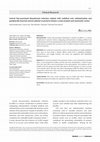
Medical Journal of Indonesia, Dec 28, 2023
BACKGROUND Central line-associated bloodstream infection (CLABSI) is a serious complication in pr... more BACKGROUND Central line-associated bloodstream infection (CLABSI) is a serious complication in preterm infants undergoing catheterization, including umbilical vein catheterization (UVC) and peripherally inserted central catheter (PICC) placement. This study aimed to compare the occurrence rate of CLABSI in preterm infants associated with UVC and PICC. METHODS We conducted a systematic review and meta-analysis of studies published from 2000 to 2023 using a random effects model from 3 databases (PubMed, ScienceDirect, and Google Scholar). This study was registered with PROSPERO (CRD42023416471). RESULTS Of 10 articles included in the systematic review, 2 were randomized controlled trials, 3 were prospective studies, and the rest were retrospective. A total of 3,962 UVCs and 2,922 PICCs were incorporated in the meta-analysis. The incidence rate of CLABSI in the UVC group was lower than that in the PICC group (1.23 versus 3.03 per 1,000 catheter days). However, the odds of developing CLABSI for infants with a UVC compared to those with a PICC were not statistically significant (odds ratio: 0.88, 95% confidence interval: 0.54-1.42). CONCLUSIONS UVCs had a lower incidence rate of CLABSI than PICCs. Therefore, additional prospective studies are required to confirm these results.

Jurnal Ekonomi Manajemen Sistem Informasi (JEMSI), Jun 20, 2023
The research objective was to determine the success rate of implementing Electronic Medical Recor... more The research objective was to determine the success rate of implementing Electronic Medical Records based on the nurse's perspective at Hermina Sukabumi General Hospital and to determine the relationship between the 6 factors of the Information Success System Model (ISSM) and the success rate of EMR. This study uses mixed methods, namely quantitative methods using the ISSM questionnaire followed by qualitative methods through in-depth interviews. Data were analyzed quantitatively through the multivariate regression analysis method, as well as qualitatively. The success rate of EMR based on the results of the ISSM questionnaire on 108 respondents was 75.82% (successful). All ISSM factors (Technology, HR, Organization, Ease of Use, Usefulness, and Net Benefit) have a significant influence on the success rate of RME (p<0.05). The use of EMR is preferred because of the ease of access and flexibility, but the difficulty found is that EMR has not been integrated with the system. Recommendation: The study found that the success rate of EMR was quite high based on the ISSM questionnaire. However, it was also found that several elements of the EMR system were not fully integrated, resulting in difficulties for nurses. Thus, it is necessary to pay attention so that the allocation of working time for nurses remains appropriate and can increase the success of EMR implementation.
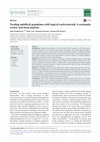
Journal of research in clinical medicine, Aug 5, 2021
Introduction: Umbilical granuloma so far can be treated with surgery or with silver nitrate. In l... more Introduction: Umbilical granuloma so far can be treated with surgery or with silver nitrate. In limited facilities, such as remote areas where the surgeons are limited, pharmacological therapy with silver nitrate or topical steroid can be administered. However, treatment with silver nitrate requires medical personnel and has unfavorable adverse effects if performed improperly. This review pointed to evaluate the effectiveness of topical steroids for treating umbilical granulomas, compared to silver nitrate therapy. Method: The literature search was done in databases including PubMed, Embase, and Google Scholar. Literature selection was performed with limitations from 2000 to 2020 to ensure the novelty and limited to articles written in English with a target population of infants younger than 6 months. To retrieve the articles, topical corticosteroids, topical steroids, and umbilical granuloma were used as keywords. Results: The findings from the included studies show similar sample characteristics. The study conducted by Brodsgaard et al. had an older mean sample age than the study of Ogawa et al. (53.4 vs. 31 days). The risk of topical steroid treatment failure on an individual study conducted by Brodsgaard et al. and Ogawa et al. was 3.0 (95%CI: 0.33-27.23) and 0.94 (95%CI: 0.40-2.21), respectively. Overall analysis, the risk of treatment failure was 1.09 (95%CI: 0.49-2.43), and there was no difference between the two interventions. Conclusions: One of the umbilical granuloma treatment options that can be considered is topical steroids, such as clobetasol propionate 0.05% or betamethasone valerate 0.12%. Although topical steroids have a longer therapeutic healing time than silver nitrate, they benefit from a better safety profile. The non-inferiority study of topical steroids to silver nitrate has not been met yet.
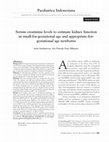
Paediatrica Indonesiana, Dec 17, 2018
Background The main parameter used to determine renal function in newborns is serum creatinine. F... more Background The main parameter used to determine renal function in newborns is serum creatinine. Fetal growth restriction during pregnancy can cause the baby to be born small-for-gestational age. Serum creatinine levels in newborns are affected by muscle mass, gestational age, as well as the number of nephrons and kidney development. Objective To determine the usefulness of serum creatinine levels as an estimate of glomerular filtration rate in small-for-gestational age and appropriate-for-gestational age newborns. Methods This cross-sectional study was conducted in May-June 2018. The subjects were full term newborn infants consisting of small-for-gestational age and appropriate-for-gestational age groups (16 subjects each), born in Bandung City Regional Public Hospital. Serum creatinine level was tested by the Jaffe method. The estimated glomerular filtration rate was calculated based on serum creatinine, infant height, and a proportionality constant using the original Schwartz method, eGFR = [k * height]/SCr. Results Of 32 subjects, there were 17 spontaneous deliveries, 14 males, and 18 females. Mean serum creatinine levels in the small-forgestational age and appropriate-for-gestational age groups were 0.94 (SD 0.36; 95%CI 0.75 to 1.14) mg/dL and 0.69 (SD 0.18; 95%CI 0.60 to 0.79) mg/dL (mean difference 0.25; 95%CI 0.05 to 0.46; P=0.009), respectively. The median estimated glomerular filtration rates (eGFR) in the small-for-gestational age and appropriate-forgestational age groups were 25.69 mL/min/1.73m 2 and 30.10 mL/ min/1.73m 2 (median difference 4.42; 95%CI 2.04 to 15.8; P=0.008), respectively. There was a weak negative correlation between serum creatinine and birth weight (r=-0.344; P=0.027). Conclusion Serum creatinine levels in small-for-gestational age newborns are significantly higher than in appropriate-for-gestational age newborns.
Jurnal Manajemen Pendidikan dan Ilmu Sosial (JMPIS), Nov 25, 2022
Sistem merit yang diatur oleh Undang-Undang (UU) No. 5 tahun 2014 tentang Aparatur Sipil Negara (... more Sistem merit yang diatur oleh Undang-Undang (UU) No. 5 tahun 2014 tentang Aparatur Sipil Negara (ASN) adalah salah satu perwujudan pelaksanaan Reformasi Birokrasi di Indonesia. Sistem merit yang diterapkan mulai dari Seleksi Calon ASN hingga pengisian Jabatan Pimpinan Tinggi (JPT) diharapkan mampu mewujudkan SDM ASN yang unggul dan berdaya saing. Dalam praktiknya, banyak tantangan maupun permasalahan yang dihadapi terkait implementasi sistem merit. Literature review ini bermaksud mengeksplorasi faktorfaktor apa saja yang memiliki hubungan dengan keberhasilan implementasi sistem merit dalam organisasi pemerintahan di Indonesia. Variabel yang digunakan antara lain faktor kepemimpinan, faktor pemahaman pegawai terkait sistem merit, faktor sistem informasi kepegawaian, faktor budaya organisasi, dan faktor politik.

medRxiv (Cold Spring Harbor Laboratory), Jan 25, 2023
BackgroundThe ingenuity to predict the progression to severe dengue is crucial in managing dengue... more BackgroundThe ingenuity to predict the progression to severe dengue is crucial in managing dengue patients. The previous meta-analysis has been performed on adults, and none has been performed specifically on children. We conducted a systematic review and meta-analysis to determine the clinical manifestations and laboratory parameters associated with the progression to severe dengue according to WHO criteria.MethodsWe focused on searching six medical databases for studies published from Jan 1, 2000, to Dec 31, 2020. The meta-analysis used random-effects or fixed-effects models to estimate pooled effect sizes. We also assessed the heterogeneity and publication bias. This study was registered with PROSPERO, CRD42021224439.ResultsWe included 49 of papers in the systematic review, and we encased the final selected 39 papers comprising 23 potential predictors in the meta-analyses. Among 23 factors studied, seven clinical manifestations demonstrated association with disease progression in children, including neurological signs, gastrointestinal bleeding, clinical fluid accumulation, hepatomegaly, vomiting, abdominal pain, and petechiae. Six laboratory parameters are associated during the early days of illness, including elevated hematocrit, elevated aspartate aminotransferase [AST], elevated alanine aminotransferase [ALT], low platelet count, low albumin levels, and elevated activated partial thromboplastin time. Dengue virus serotype 2 (DENV-2) and secondary infections were also associated with severe disease progression.ConclusionThis finding supports the use of the warning signs described in the WHO 2009 guidelines. In addition, monitoring serum albumin, AST/ALT levels, identifying infecting dengue serotypes, and immunological status could improve the risk prediction of disease progression.
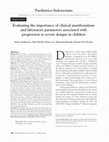
Paediatrica Indonesiana
Background The ability to predict the progression to severe dengue is crucial in managing patient... more Background The ability to predict the progression to severe dengue is crucial in managing patients with dengue fever. Severe dengue is defined by one or more of the following signs: severe plasma leakage, severe bleeding, or severe organ involvement as it can be a life-threatening condition if left untreated. Objective To identify clinical manifestations and laboratory parameters associated with dengue hemorrhagic fever disease progression in children by systematic review and meta-analysis. Methods We searched six medical databases for studies published from Jan 1, 2000, to Dec 31, 2020. The meta-analysis used random-effects or fixed-effects models to estimate pooled effect sizes. We assessed heterogeneity using Cochrane Q and I2 statistics, publication bias by Egger’s test and LFK index (Doi plot), and categorized subgroup analysis by country. This study was registered with PROSPERO, CRD42021224439. Results We included 49 papers in the systematic review, and we encased the final se...
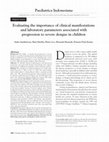
Paediatrica Indonesiana
Background The ability to predict the progression to severe dengue is crucial in managing patient... more Background The ability to predict the progression to severe dengue is crucial in managing patients with dengue fever. Severe dengue is defined by one or more of the following signs: severe plasma leakage, severe bleeding, or severe organ involvement as it can be a life-threatening condition if left untreated. Objective To identify clinical manifestations and laboratory parameters associated with dengue hemorrhagic fever disease progression in children by systematic review and meta-analysis. Methods We searched six medical databases for studies published from Jan 1, 2000, to Dec 31, 2020. The meta-analysis used random-effects or fixed-effects models to estimate pooled effect sizes. We assessed heterogeneity using Cochrane Q and I2 statistics, publication bias by Egger’s test and LFK index (Doi plot), and categorized subgroup analysis by country. This study was registered with PROSPERO, CRD42021224439. Results We included 49 papers in the systematic review, and we encased the final se...
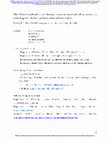
BackgroundThe ingenuity to predict the progression to severe dengue is crucial in managing dengue... more BackgroundThe ingenuity to predict the progression to severe dengue is crucial in managing dengue patients. The previous meta-analysis has been performed on adults, and none has been performed specifically on children. We conducted a systematic review and meta-analysis to determine the clinical manifestations and laboratory parameters associated with the progression to severe dengue according to WHO criteria.MethodsWe focused on searching six medical databases for studies published from Jan 1, 2000, to Dec 31, 2020. The meta-analysis used random-effects or fixed-effects models to estimate pooled effect sizes. We also assessed the heterogeneity and publication bias. This study was registered with PROSPERO, CRD42021224439.ResultsWe included 49 of papers in the systematic review, and we encased the final selected 39 papers comprising 23 potential predictors in the meta-analyses. Among 23 factors studied, seven clinical manifestations demonstrated association with disease progression in...
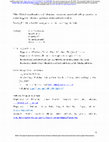
BackgroundThe ingenuity to predict the progression to severe dengue is crucial in managing dengue... more BackgroundThe ingenuity to predict the progression to severe dengue is crucial in managing dengue patients. The previous meta-analysis has been performed on adults, and none has been performed specifically on children. We conducted a systematic review and meta-analysis to determine the clinical manifestations and laboratory parameters associated with the progression to severe dengue according to WHO criteria.MethodsWe focused on searching six medical databases for studies published from Jan 1, 2000, to Dec 31, 2020. The meta-analysis used random-effects or fixed-effects models to estimate pooled effect sizes. We also assessed the heterogeneity and publication bias. This study was registered with PROSPERO, CRD42021224439.ResultsWe included 49 of papers in the systematic review, and we encased the final selected 39 papers comprising 23 potential predictors in the meta-analyses. Among 23 factors studied, seven clinical manifestations demonstrated association with disease progression in...
Physical, mental emotional, social development in an adolescents put them in a psychosocial vulne... more Physical, mental emotional, social development in an adolescents put them in a psychosocial vulnerability so that the mental emotional and behavioral problem can be occured. Detection of emotional and behavioral problems in early stage is expected to help them to get better virtue for their future.
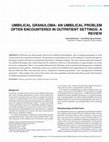
International Journal of Medical Reviews and Case Reports, 2021
Newborns can often present with several umbilical abnormalities, such as benign granulomas or mor... more Newborns can often present with several umbilical abnormalities, such as benign granulomas or more serious lesions due to persistent remnants. The persistence of granulation tissue in the umbilical is common and quite be alarming to parents and often encountered by physicians in outpatient settings. The most common signs and symptoms are umbilical discharge and a round lump from the umbilicus. If the size of the granuloma is large enough it can easily be seen by examination. There is very minimal literature that elaborates on the treatment and management of umbilical granuloma of such patients. A literature search was carried out in PubMed and Google Scholar for articles published between 2002 and 2020, with keywords such as "treatment of umbilical granuloma" and "management of umbilical granuloma". These articles were used to draw down some basic guidelines and clinical tips that can aid in the treatment of umbilical granuloma in limited facilities.

Paediatrica Indonesiana, 2018
Background The main parameter used to determine renal function in newborns is serum creatinine. F... more Background The main parameter used to determine renal function in newborns is serum creatinine. Fetal growth restriction during pregnancy can cause the baby to be born small-for-gestational age. Serum creatinine levels in newborns are affected by muscle mass, gestational age, as well as the number of nephrons and kidney development. Objective To determine the usefulness of serum creatinine levels as an estimate of glomerular filtration rate in small-for-gestational age and appropriate-for-gestational age newborns. Methods This cross-sectional study was conducted in May-June 2018. The subjects were full term newborn infants consisting of small-for-gestational age and appropriate-for-gestational age groups (16 subjects each), born in Bandung City Regional Public Hospital. Serum creatinine level was tested by the Jaffe method. The estimated glomerular filtration rate was calculated based on serum creatinine, infant height, and a proportionality constant using the original Schwartz meth...

Spina bifida is a birth defect that occurs due to the disruption of the formation of the neural t... more Spina bifida is a birth defect that occurs due to the disruption of the formation of the neural tube with an incidence of 1–10 cases per 1000 live births. Spina bifida can appear as an occulta or aperta type, and the latter consists of meningocele, myelomeningocele, and myeloschisis. We reported a case of a term male newborn who was presented with lethargic, bradypnea, suction reflex abnormalities, and paralysis of lower extremities. A defect was found in the spine in the thoracolumbar region showed a placode with no meningeal and skin covering, suggestive of a myeloshisis. The patient was treated in the neonatal intensive care unit, was placed on non-invasive ventilation with successful weaning, parenteral nutrition, systemic antibiotics regimen, and wound care. The patient was consulted with a neurosurgeon and was subjected to an ultrasound examination of the head that led to hydrocephalus. After experienced clinical improvement and oral tolerance, the patient was allowed for disc...

Journal of Research in Clinical Medicine
Background: Umbilical granuloma so far can be treated with surgery or with silver nitrate. In lim... more Background: Umbilical granuloma so far can be treated with surgery or with silver nitrate. In limited facilities such as in remote areas where the surgeon is limited, pharmacological therapy with silver nitrate or topical steroid can be given. However, treatment with silver nitrate requires medical personnel and has unfavorable adverse effects if done by improper technique. This systematic review aimed to evaluate the effectiveness of topical steroid for treating an umbilical granuloma compared to silver nitrate therapy. Method: The literature search was done using search engines including PubMed, Embase, and Google Scholar. Literature selection was performed with limitations from 2000 to 2020 to get the novelty and written in the English language with a target population of infants less than 6 months were included. To retrieve the articles, topical corticosteroids, topical steroids, and umbilical granuloma were used as keywords. Results: The findings from the included studies show ...

Uploads
Papers by Indra Sandinirwan
METHODS: Medical records of pediatric sepsis patients (1 month - 18 years) admitted to the emergency room, wards, high care unit, and intensive care unit from June to July 2024 were analyzed using SPSS version 26. The discriminatory ability of SI and D/S for predicting septic shock was assessed using the Area Under the Receiver Operating Characteristic Curve (AUROC).
RESULTS: A total of 24 pediatric patients with sepsis were included in the study (13 males, 11 females), with a mean age of 6.75 years (range 1.5 months to 17 years). Of these, 17 developed septic shock, with 59% mortality (10/17). Among the 7 patients who did not develop shock, the survival rate was considerably higher at 86% (6/7). The mean SI was 1.8 (SD 0.52) and the mean D/S ratio was 0.61 (SD 0.09). The SI (AUROC 0.613, cut-off value 1.03, sensitivity 94%) outperformed the D/S ratio (AUROC 0.366) in predicting septic shock.
CONCLUSION: The SI demonstrated superior predictive ability for septic shock compared to the D/S ratio. These findings suggest that the SI may be a valuable tool in identifying pediatric sepsis patients at risk of developing septic shock.
METHODS: Medical records of pediatric sepsis patients (1 month - 18 years) admitted to the emergency room, wards, high care unit, and intensive care unit from June to July 2024 were analyzed using SPSS version 26. The discriminatory ability of SI and D/S for predicting septic shock was assessed using the Area Under the Receiver Operating Characteristic Curve (AUROC).
RESULTS: A total of 24 pediatric patients with sepsis were included in the study (13 males, 11 females), with a mean age of 6.75 years (range 1.5 months to 17 years). Of these, 17 developed septic shock, with 59% mortality (10/17). Among the 7 patients who did not develop shock, the survival rate was considerably higher at 86% (6/7). The mean SI was 1.8 (SD 0.52) and the mean D/S ratio was 0.61 (SD 0.09). The SI (AUROC 0.613, cut-off value 1.03, sensitivity 94%) outperformed the D/S ratio (AUROC 0.366) in predicting septic shock.
CONCLUSION: The SI demonstrated superior predictive ability for septic shock compared to the D/S ratio. These findings suggest that the SI may be a valuable tool in identifying pediatric sepsis patients at risk of developing septic shock.